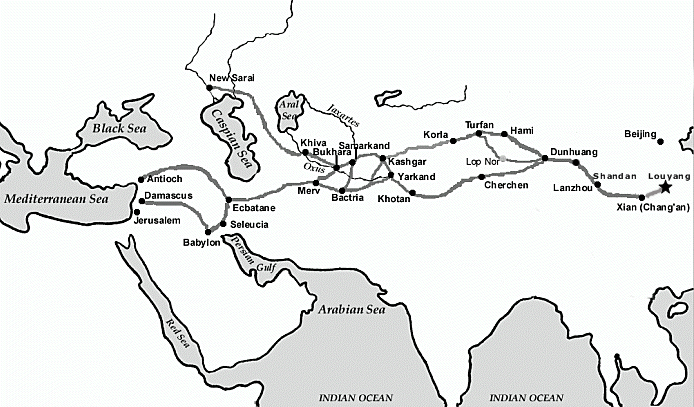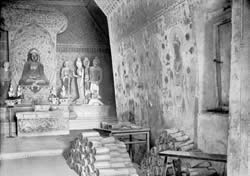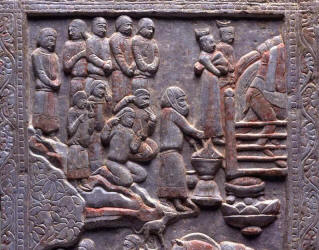
Contents

Sugd / Turan
Turan
Sugd-Uzbekistan Region
Sugd-Tajikistan Region
Sogdian Trade. Silk Roads
Zoroastrianism in China
Sugd / Turan Pages:
» Turan
» Sugd - Uzbekistan Region
» Sugd - Tajikistan Region
» Suggested prior reading: Aryan Trade
» Suggested additional reading: Hormozgan & Trade
Sogdian Aryan Trade Along the Silk Roads
From amongst the sixteen nations of the Vendidad (the Aryan affiliated nations), the Sogdians appear to have become the dominant traders. They have left evidence of their trading activities as well as settlements, along the Silk Roads from Asia Minor to the Indian subcontinent, to the steppes in the north, and in China.
According to Francis Wood in The Silk Road: Two Thousand Years in the Heart of Asia [Berkeley, CA: University of California Press (2002). pp. 65–68. ISBN 978-0-520-24340-8], the Sogdians dominated the trade along the Silk Route from the 2nd century BCE until the 10th century CE. Around the 3rd - 4th century CE, the Sogdians left more than 600 inscriptions in the high passes of the upper Indus river, while their Bactrian counterparts left ten inscriptions (Sims-Williams, 1989, 1992).
Sogdian trading activities, however, started much earlier. Some of the Sogdian inscriptions on rocks in the northern Indus (Hapta Hindu) valleys (now in northern Pakistan), as well as artefacts found in Indus Valley settlements and in Central Asia, testify to their activity during the Stone Ages along routes south into the Indian subcontinent.
The Sogdians, and their neighbours, employed the knowledge, skills and connections the Sogdians developed during their wide-ranging travels in several ways. The Chinese and the powerful nomadic Turkic tribes of the steppes often used Sogdian merchants as go-betweens, and their records of these activities give us more information about Sogdian trading activities. During 568-75CE, the Sogdians used their diplomatic influence with the Turks to open up new markets.
In addition, the Sogdians were manufacturers as well. They became proficient in the making of silk fabrics, brocade and blue ceramic-ware.
The Sogdians were therefore traders, manufacturers, artisans, world travellers, adventurers, diplomats, and resolvers of international conflict. The predecessor cities to Samarkand and Bokhara such as Afrasiab, literally and figuratively, became the cross-roads of the world.
Sogdians and the Silk Trade
The Sogdians were intimately involved in the lucrative silk trade between the silk manufacturing centres of Tashkurgan, Khotan and Kashgar in the eastern Aryan lands (as well as China) and the markets of Europe. The far eastern Aryan lands east of Tashkurgan, Khotan and Kashgar were known to classical Western writers as Serica meaning 'silk' in Latin.
The Sogdian involvement in the silk trade continued up to the end of the Sassanid-Persian rule in the mid 7th century BCE. Henry Yule in an essay included in Captain John Wood's A Journey to the Source of the River Oxus, (London) 1872, notes, "The troubles of the time (6th century BCE) had interrupted the trade in silk, which the people of Soghd carried on to their great profit, no doubt as intermediaries in the trade from China and Khotan." Further, "...the Sogdians, through Maniakh (cf. the modern name Maneck) their prince, prevailed on Dizabulus* to open communication with Byzantium, in order that a direct trade might be initiated with the great Western consumers of silk." [*Dizabulus was a reputed Turkic king of the eastern Aryan lands. According to Menander Protector who we cite below, these Turkic peoples were anciently called Sacae i.e. the Saka. If that is so, we have a confusion here between the early Saka and the later Turkic peoples. The Turkic peoples of Central Asia could very well have been a blended people of the aboriginal Saka and migrant Turks from the Altai region of Siberia.] Yule adds, "These Sogdians... we may suppose to have been the forefathers of the present unwarlike and trafficking (traders) Tajiks of Bokhara."
According to fragments of the end-sixth century writings of Menander Protector, the embassy referred to above was received by Roman Emperor Justin in Byzantium in 568 CE. The Romans were the largest consumers of Eastern silk and the largest potential customers for the Sogdians' wares. Earlier the Sogdians had petitioned Dizabulus to send them on a similar embassy, a diplomatic mission, to the Persian-Sassanian court to allow free passage of their silk trade. But since Dizabulus was a reputedly Turkic, Sassanian king Khosrau I (531-579 CE) what not readily inclined to collaborate with the Sogdians' Turkic overlords who they considered untrustworthy - even though it was the Sogdians who were petitioning the court (there might have been Turkic officials present in the mission as well). [Eastern Aryana succumbed to Turkic inroads likely after a weakening of central Iranian control after Alexander's invasion. Parts would later be brought back under Sassanian-Aryan control but likely never to it full extent.] If the Sogdians caravans were not able to pass through Persian Iran, then the Sogdians may have had to use a route around the north of the Caspian Sea.
In these accounts above, we see a continuation of the ancient Sogdian involvement not just in silk trade along the Silk Roads, but also in the diplomacy and diplomatic concord between neighbouring kingdoms needed to keep the Silk Roads open. We also see how necessary it was for the nations through which the Silk Roads passed to have good relations with one another. While the roads were primarily within the Aryan federation of kingdoms, that compact could be instituted by the Aryan king-of-kings. When the Aryan Empire collapsed first on account of Alexander's invasion and then after the Arab invasion, overland trade was gradually replaced by maritime trade, and the Sogdian domination of the silk trade came to an end.
Sogdians & Zoroastrianism in China
 |
| Aryan Sogdian Silk Roads showing the Chinese and other cities along the route |
The first Chinese records of Central Asia written during the Han dynasty (206 BCE - 220 ACE) record that the Sogdians were talented merchants. The Sogdians and other Aryans had been trading for millennia before that time.
At Turfan, now in north-western China, Chinese documents found in the cemeteries of the city mention several hundreds of Sogdians (de la Vaissière and Trombert, 2004), and a fragment of the customs register regarding the caravans shows that among 35 operations, the Sogdians were involved in 29 (Skaff, 1998, pp. 89-95). This activity is mentioned in sale contracts, records of lawsuits, and census lists. They played a major part in all aspects of life in the oasis, besides its commerce. Two thousand years ago, Turfan was the easternmost of the lands with a substantial Aryan / Sogdian population and at the same time one of the farthest outposts of the Chinese Han empire.
The Sogdians established trading colonies in China dealing in commodities such as gold, silver, camphor, pepper and other spices, musk, wheat, silk, and other kinds of cloth. Evidence of Sogdian settlements in China have been found as far East as the Chinese capital Luoyang. Sogdian letters dating from 313-314 CE discovered in their staging post at in Dunhuang, indicate that there was a substantial Sogdian community settled in Dunhuang. The Sogdian letters indicate that the traders of Dunhuang communicated with a network of subsidiary Sogdian merchants in various places in China. The Dunhuang Sogdians in turn took direction from their principles in Samarkand and one of the letters discovered was from was Samarkand. The Sogdian trade with China grew and some of the exotic products popular later in Tang China (618 - 906 CE) were imported from Samarkand.
There is written evidence that a Zoroastrian temple existed in Dunhuang in the fourth century CE, which was still flourishing in the early 10th century.
Sogdian merchants also went west and were involved in the development of the silk trade giving the name Silk Roads to the trade routes. The trading continued until the sea routes and political instabilities led to a decline in trade along the Silk Roads. They were vibrant, exciting, prosperous, cosmopolitan places to be and their fame spread far and wide to distant lands.
Earliest Known Avestan Manuscript in Sogdian

|
| Zoroastrian prayer, the Ashem Vohu British Library Or. 8212/84 (Ch.00289) |
The earliest surviving Avestan manuscript (the Avesta being the Zoroastrian scriptures), is a the 10th century CE fragment found in Dunhuang, China (see below). The next earliest extant Avestan texts come from Iran and India and date from the end of the 13th century ACE - three hundred years after the Sogdian manuscript was written.
The manuscript is presently housed in the British Library.
The body of the text is written in standard ninth century CE Sogdian using the Avestan script. It describes Zoroaster addressing God supreme. The preface to the text consists of two lines of the Ashem Vohu prayer written in a dialect that is similar to Achaemenid Old Persian. For example, the standard Sogdian equivalent for the Iranian Avestan asha or ashem is rtu (cf. Vedic Sanskrit) or reshtyak. The manuscript uses rtm, a form identical with Achaemenid Old Persian rtam.

|
| Library Cave, Dunhuang, in 1907 |
According to the British Library web-page, "This manuscript was one of 40,000 or so books and manuscripts hidden in one of the 'Caves of a Thousand Buddhas' - a cliff wall near the city of Dunhuang (a town on the Silk Road in northwest China) honeycombed with 492 grottoes cut from the rock from the fourth century onwards and decorated with religious carvings and paintings. The secret library was sealed up at the beginning of the 11th century, probably under threat from the Karakhanids who had taken Khotan in 1006.
"The cave was discovered in 1900 by the Daoist monk Wang Yuanlu who presented manuscripts and paintings to local officials, hoping in return for financial support to pay for conservation work. When the archaeologist and explorer Aurel Stein arrived there in 1907, Wang Yuanlu sold him large numbers of manuscripts and paintings which are now in the British Library, the British Museum, the Victoria and Albert Museum, and the National Museum Delhi."
Princess Jun Zhezhe Letter

|
| letter written by Princess Jun Zhezhe British Library Or. 8210/S.2241 (Ch.00289) |
Zoroastrianism in China was not limited to the Sogdians. The British Library also has a letter written by Princess Jun Zhezhe of the Guangzhou Uyghurs (also spelt Ganzhou Uighurs) to her friend Madame Sikong, mistress of the North House. According to The Silk Road, a book published by the British Library and written by Susan Whitfield, Ursula Sims-Williams, British Library, in the letter to Madame Sikong, the princess "mentions lighting a fire in the Zoroastrian Fire Temple in order 'to bring prosperity along the road.'"
The British library does not give us a date for the letter but notes, "This letter in Chinese provides rare evidence of Zoroastrianism in tenth century Dunhuang."
The British library site also mentions "Sogdian merchants and Persian envoys had taken their faith south into India and as far east as China and there were temples in Chang'an (Xian) and Luoyang, but little evidence of local converts."
The Uyghurs are of Turkic origin in the Altai Mountain region where Mongolia, Siberia and China meet.
Sogdian Zoroastrian Funerary Couches in China
Sixth-century CE funerary couches (raised decorated stone benches on which coffins are placed) of wealthy Zoroastrian-Sogdian traders from Central and Northern China, depicting Zoroastrian scenes have been discovered, and are on display in museum around the world. The two sets of panels from funerary couches show a priest wearing the padam (the white mask that Zoroastrian priests wear so as not to defile the flame), a sagdid dog (a dog that is able to confirm death), and deceased souls crossing the Chinvat Bridge to the next life. (Also see our page on Funeral Customs.)
One set of late 6th to early 7th century ACE panels from northern China and the Sui period reside in the Miho Museum in Shiga, Japan (additional page).
|
Another set of panels from Zhangdefu (Also see: Turania , Go Antiques & Transoxia) near Anyang in Henan province, is scattered among three museum collections: the Museum fur Ostasiatische Kunst in Cologne, the Museum of Fine Arts in Boston, and the Musee National des Arts Asiatiques - Guimet in Paris.

|
| Sogdian Dancer, Shandan Municipal Museum, Tang Dynasty, 618-906 CE. Bronze. Height: 13.7 cm. Gansu Province, China |
Sogdian Dancer in China
The bronze casting of the image to the right is that of a Sogdian dancer. The 14 cm. high 7th century figurine is presently housed in the Shandan Municipal Museum, Gansu Province, China. Shandan lies between Dunhuang and Lanzhou, along the Silk Road and just below the border of the Autonomous Region of Inner Mongolia. Shandan is also situated along the Great Wall of China.
The Sogdians were avid dancers with a jest for life. They would have to had been a fun-loving and adventurous people if they were to travel and settle in communities far from their native land. They even danced in the courts of the Tang Dynasty (618-906 CE), and were sought after by royalty for their dancing skills.
Notice the figure's large nose. Though greatly exaggerated in the figurine, the large nose was a defining feature of Sogdians, and indeed, a large number of Aryans. Even today, the Parsees and Iranis of India are distinguished by their large noses. Besides all the other features such as clothing, hat and shoes, the nose eliminates any possibility of the figure representing an ethnic Chinese dancer.
Also see:
» Chinese Pictorial Space at the Cultural Crossroads by Dr.Annette L. Juliano
» China Heritage Newsletter Shi Anchang, Huotan yu Jisi Niaoshen (Fire Altars and Avian Deities as Sacrificial Officiants)
» Top

